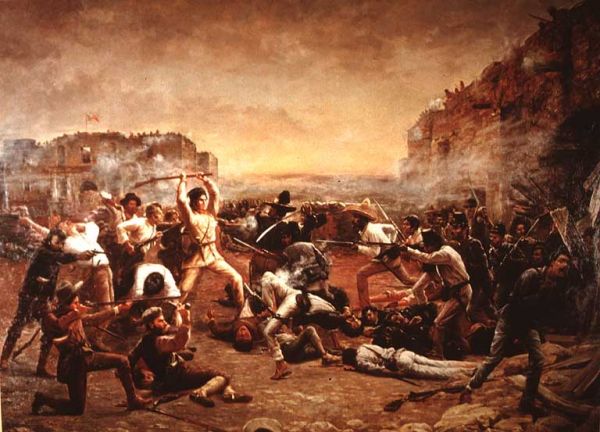
Onderdonk's The Fall of the Alamo
Have
you visited the Alamo? You won't be able to access the basement, but
you can explore the beautifully preserved remains of the battle site,
explained in rich detail by tour guides and signs.Now how did that happen? How did people in Japan learn about the Alamo? Franz-Stefan Gady explains at The Diplomat.
In the 1870s, American Civil War veteran William S. Clarke, formerly the colonel of a Massachusetts regiment of volunteers, taught at an agricultural college in Japan. Among other courses, he taught on military history. In it, he told the story of the Alamo to young student Shiga Shigeta.
Oda Nobunaga as he was depicted in the anime series Battle Girls - Time Paradox)
Shigetaka
felt moved by that story, especially its resemblance to a similar
incident in Japanese history. In 1575, at the Battle of Nagashino, a
small garrison withstood a siege by a massive enemy force until relief
came from the famed general Oda Nobunaga. So Shigetaka began his poem
with these words:One hundred fifty are besieged by five thousand;The determination of these brave foreigners so far away from Japan was familiar to Shigetaka and other people in Meiji Japan. Franz-Stefan Cady writes at The Diplomat:
Not only the provisions but the ammunition is all gone.
Thirty-two men hear the news and hurry to the scene.
The heavy strokes of their sabers lead them into the fortress, through the ranks of the enemy to see
The commander of the fortress wet with blood,
And his men reeling against the walls with exhaustion but with swords in hand.
Shigetaka grew up during the Meiji Restauration in Japan, a time of sweeping social upheaval when many Japanese felt that Western influences would supplant their country’s traditional culture. Perhaps then, he saw the battle as an opportunity to dispel some of the fears held by the Japanese about the West by illustrating that traditional (i.e. heroic or warrior) culture was comparable in both the United States and Japan.
The Japanese scholar’s effort to mythologize the Battle of the Alamo was thus on the one hand to emphasize a commonality of culture, and on the other hand a response to the dawn of Japanese Modernity. […]
Emphasizing the heroism of white Anglo-Texans and their dedication to ideals of freedom (and disregarding the contribution of Mexicans fighting for Texas in the 1830s) thus served to comfort Anglo-Texans in their struggles with Modernity, when they, like the Japanese during the Meiji Restauration, feared to lose their traditional identities amidst the social changes that were occurring in Texas during that time.

No comments:
Post a Comment